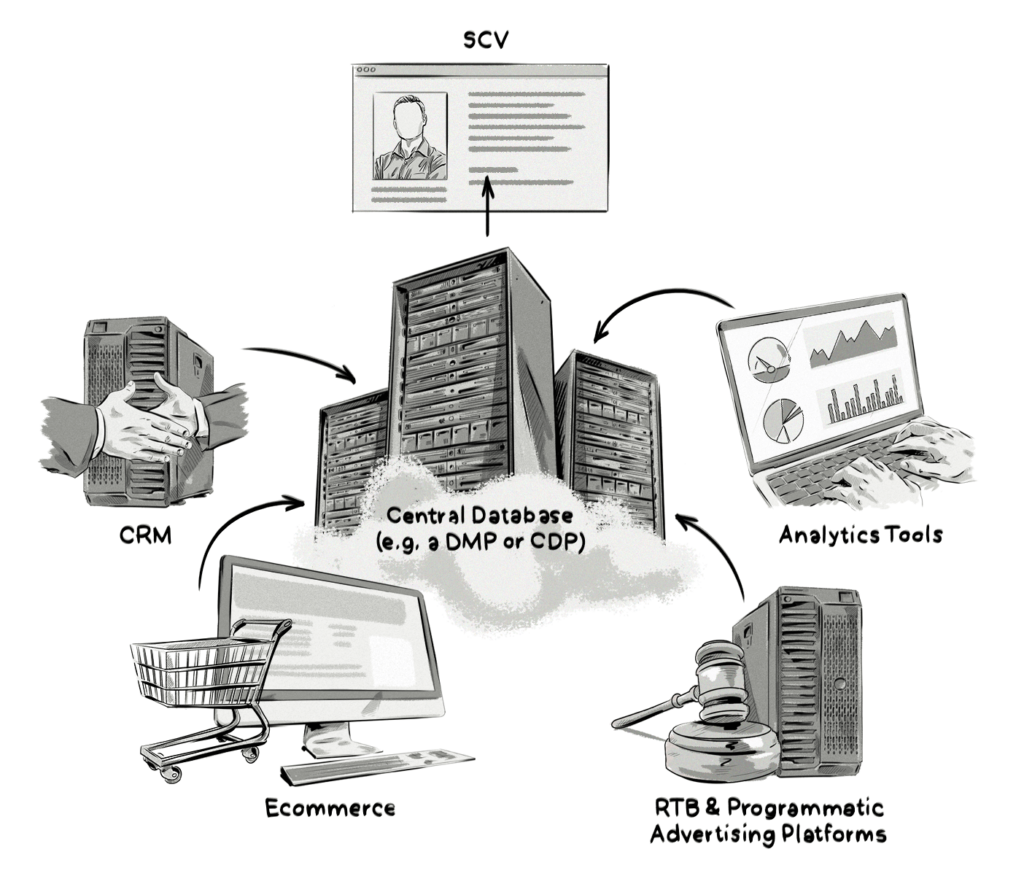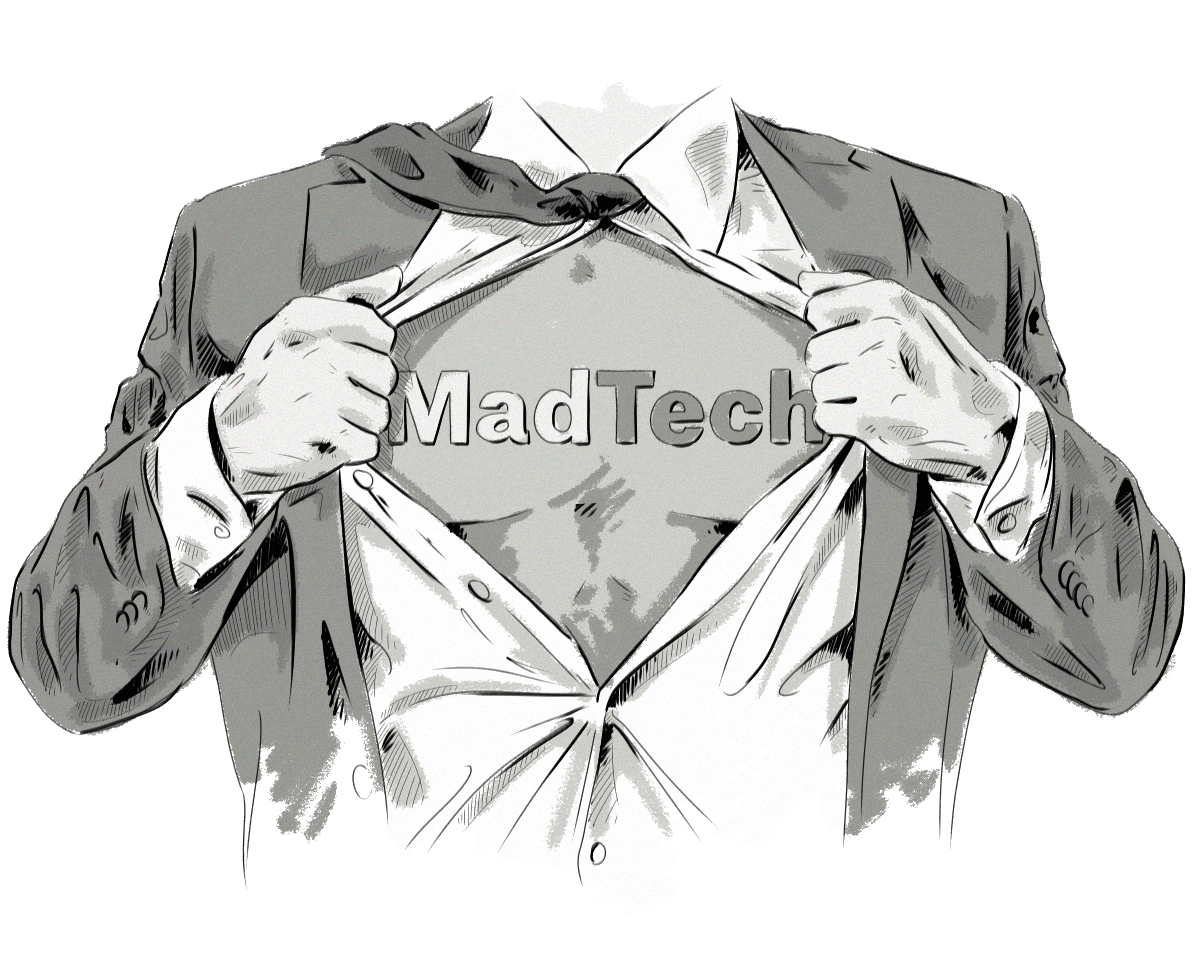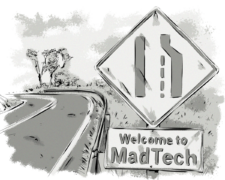Data is everywhere; the main challenge for marketers and advertisers is to know how to properly collect and leverage it. With MarTech platforms using data to display personalized messages in owned media, and AdTech platforms using it to display targeted messages in paid media, there is a strong push towards a single technology offering personalization across all media – MadTech.
AdTech and MarTech have evolved so much that they’ve become very difficult to tell apart. Today’s advertising-technology platforms are more than just tools used to increase brand awareness and reach new customers. Likewise, marketing-technology platforms like CRMs are not just passive databases of customers; they run on vast amounts of data and offer an array of new capabilities like social-media integration, AI, holistic profiling, and much more. What MarTech and AdTech increasingly have in common, however, is data.
What is MadTech?
The term MadTech – a portmanteau of the words marketing, advertising, and technology – was coined by David Raab to describe the current trend in the development of technology platforms: the hybridization of AdTech and MarTech. It is all about data, connectedness, and convergence of a number of technologies and data sources including big data, internet of things (IoT) and machine learning.
MadTech is founded on the principle of data synergy and takes the idea of SCV (single customer view) to another level. This is done through de-siloing and combining related sets of data into easily accessible, shared repositories enriched with data pulled from multiple devices that a single person could use, including emerging technologies like IoT and wearables. This synergy makes the related parts of AdTech and MarTech data more valuable and available (although not for free). Most importantly, the data isn’t siloed into individual companies’ systems.
Data Synergy for Single Customer View (SCV)
A single customer view is a concept either synonymous with, or part of, user-centric marketing, people-based marketing and omnichannel marketing. It is created by consolidating various pieces of information about customers from various sources and is seen as the foundation of MadTech.
In many cases, those data sources can be systems scattered across various departments of the organization – marketing, sales, service and product design, etc. There’s an urgent need to aggregate the data into shared repositories to create the SCV.
What Types of Data Can Be Used to Create an SCV?
- Behavioral data: total number of pageviews, goals completed, and URLs visited.
- RTB and programmatic data: includes data collected during online media buys, such as interactions with ads (e.g. clicks) and other user data.
- Ecommerce and transactional systems: the number of products purchased (both online and offline), cart value, order/renewal dates, product abandonments (abandoned baskets), product returns, etc.
- CRM and offline data: provided address information, telephone information, email address information, social-network data, etc.
- GDPR-consent data: consent given by users, which may be a prerequisite to using all of the above. This is especially important because under the GDPR, consent is required for certain data-processing purposes – e.g. for use in content personalization and remarketing.

With SCVs in place, companies can put them to good use in their advertising and marketing activities.
How MadTech Was Formed
It’s not surprising that MadTech is quickly gaining traction; it promises huge benefits for both advertisers and marketers. However, it is not a completely novel concept. Data-management platforms (DMPs) have been around for some time now and easily match the definition of a MadTech platform.
Below is a look at the definition of AdTech, MarTech and MadTech:
- MarTech uses marketing databases (e.g. CRMs and CDPs) storing detailed information about interactions with identified individuals.
- AdTech typically uses DMPs and stores information gathered from many sources. DMPs combine capabilities inherent in MarTech and AdTech, which positions the platforms in between the two realms. A DMP allows advertisers to reach new audiences (via lookalike modeling) and improve media-buying decisions during real-time bidding (RTB). A DMP enables marketers to craft and deliver personalized communications to existing and future customers.
- MadTech promises the convergence of the above technologies and seamless connection of internal and external (first- and third-party) data for SCV. On top of that, MadTech takes advantage of all available cutting-edge technologies to link users to specific addresses, locations and devices, including new categories of internet-enabled devices like wearables, internet-of-things devices, etc.
Below are three possible use cases of a MadTech approach to advertising and marketing:
Use Case #1: Personalized Messaging Across All Channels
Enrichment of third-party data with the more accurate first-party data, such as products previously browsed in the online store, and taking advantage of integrated data platforms that MadTech promises, would allow personalized messaging with granular targeting and retargeting.
Following the principles of MadTech, the brand could create audiences based on detailed data collected via their ecommerce store (first-party data) and upload them to a DSP. From there, they could target online users who very specifically match their campaign’s targeting criteria. This allows companies to utilize their own first-party data to a bigger extent, provided the data was collected lawfully according to the GDPR for online media buying (e.g. retargeting) and marketing purposes.
How Personalization Works in MarTech, AdTech and MadTech: A Comparison
- MarTech enables personalized messaging with first-party data from owned media (e.g. email and websites, CRMs).
- AdTech delivers personalized messages to audiences using third-party data and paid media (i.e. display ads, paid search, social networks)
- MadTech is about combining these features to deliver personalized messages across all available media (including paid media). This is becoming possible due to increasing overlap between externally owned channels and “internal” systems. There is evidence that confirms carefully selected messages can add value for customers and make them more likely to convert. Also, companies can streamline their media spend.
Use Case #2: Improved Attribution, User Journeys and Reporting
SCV enables marketers to create contextual and personalized customer experiences. With improved attribution reports, marketers can analyze how users interact with their brand, focus on the most efficient touch-points along a single person’s user journey and automatically minimize spend on other inefficient touch-points.
We’ve all been there – you keep seeing the spooky Nike ads even though you already purchased a pair two weeks ago – but because MadTech works across all channels and treats them as “your own funnel” (as would happen for a CRM platform), it offers improved conversion reporting.
For example, a unified MadTech data platform would automatically remove people from the sales funnel the moment they exit an audience segment, or after conversion, and stop displaying Nike ads for them in all channels. The net effect: less money spent on irrelevant messaging.
User Journeys and Attribution in AdTech, MarTech and MadTech: A Comparison
- MarTech systems manage complex, multi-step campaigns and measure their impact on the customer journey with advanced attribution.
- AdTech systems use real-time bidding and behavior-based recommendations to deliver the highest response at the lowest cost.
- MadTech builds upon advanced analytics and content personalization. It helps marketers pick the best time and place to deliver messages, and update audiences based on new data (purchases, conversions, etc.). Machine-learning algorithms deliver optimized offers without human decisioning. Such capabilities may be nothing new, but with data synergy, they can be further refined, commodified and integrated into a single, functional technology platform.
Use Case #3: AI and Machine Learning
If there are two terms in AdTech and MarTech that are guaranteed to make a person roll their eyes, it would be artificial intelligence (AI) and machine learning (ML). While these terms may help make a given AdTech or MarTech platform appear futuristic, the true power and potential of AI and ML are not here yet.
However, for the most part, AI and ML are nothing more than algorithms, which, when created for the purpose of decision making and optimizing certain processes, can be greatly improved with more quality and accurate data.
When thinking about AI and ML in terms of MadTech, there’s no shortage of possibilities. Case in point: Amazon promises an interesting implementation of artificial intelligence and machine learning for automation of processes. Their predictive-shipping system will (purportedly) deliver products to the customers before they actually place an order. Can this be real? The term predictive shipping has already been patented and its possible future implementation could be based on the vast trove of behavioral data Amazon already has about its users.
With the help of SCVs and a centralized database, companies like Amazon can utilize AI and ML to optimize the decision-making processes. AI can also support DSPs in predicting which impressions will drive the best results, and become better at it fed by user data.
There’s also the opportunity to create a simple set of rules to improve various labor-intensive tasks, such as handling support requests.
Final Thoughts
From a marketer’s point of view, the benefits of MadTech are twofold. Marketers have more complete insights about existing customers. Conversely, because businesses have deeper insights about their existing customers, they can streamline their advertising to reach new, potential customers. This reduces the cost of all advertising efforts and makes them more effective.
MadTech repackages a number of available AdTech/MarTech technologies and data sources into a brand new, fully functional technology platform, integrated and commodified. As David Raab puts it himself, the shift to MadTech “will result in a renewed focus on core marketing skills such as branding, positioning, value definition and […] creative development.”
The technology behind MadTech will soon become more sophisticated, but also more available, down to a level where marketers can stop thinking in terms of technology and focus on their actual jobs instead: reaching customers who need and want their products or services.








